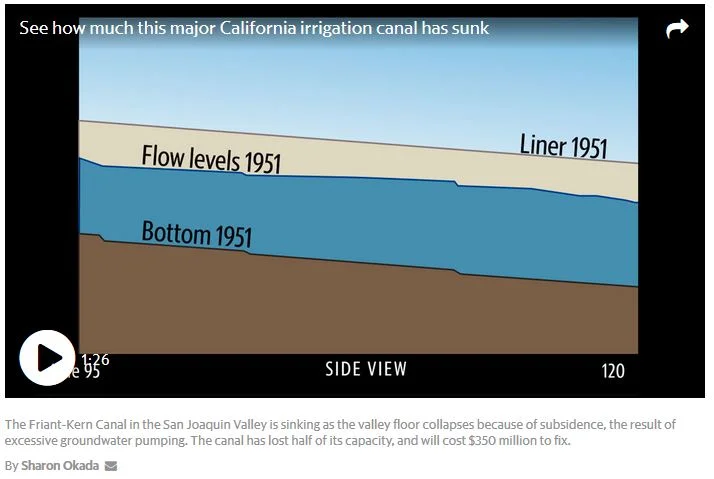The following article appeared in the Sacramento Bee and Fresno Bee on July 13, 2018. It can be accessed at: https://www.sacbee.com/news/state/california/water-and-drought/article214631455.html.
The Valley floor is sinking, and it’s crippling California’s ability to deliver water
By Dale Kasler & Phillip Reese
July 13, 2018
Terra Bella - Completed during Harry Truman’s presidency, the Friant-Kern Canal has been a workhorse in California’s elaborate man-made water-delivery network. It’s a low-tech concrete marvel that operates purely on gravity, capable of efficiently piping billions of gallons of water to cities and farms on a 152-mile journey along the east side of the fertile San Joaquin Valley.
Until now.
The Friant-Kern has been crippled by a phenomenon known as subsidence. The canal is sinking as the Valley floor beneath it slowly caves in, brought down by years of groundwater extraction by the region’s farmers.
Along a 25-mile stretch of Tulare County rich with grapevines and pistachio trees, the canal has fallen so far — a dozen feet since it opened in 1951 — that it has lost more than half of its carrying capacity downstream from the choke point. Water simply can’t get through like it’s supposed to.
“It ponds up; you lose capacity and that ability to move water through the system,” said Douglas DeFlitch, chief operating officer at the Friant Water Authority. The authority operates the canal for the U.S. Bureau of Reclamation’s Central Valley Project.
Although subsidence has been a problem for decades, it accelerated as groundwater pumping expanded during the recent drought. Now it’s reaching a crisis point on the Friant-Kern, and California voters are being asked to fix it.
A proposition on the November ballot would raise billions of dollars for a variety of water projects around the state, including roughly $350 million to repair the Friant-Kern.
Proposition sponsor Gerald Meral, a prominent environmentalist, said it’s in Californians’ interests to ensure the flow of water to the east side of the Valley. The Friant-Kern brings water to the city of Fresno, numerous small towns and 17,000 farmers.
“Keeping 1 million acres of land in the Friant service area (in production) is a public good,” said Meral, a former deputy secretary of the state Natural Resources Agency.
So far no organized opposition has emerged to Meral’s proposition.
The Friant-Kern’s woes illustrate the enduring nature of California’s water problems. The epic five-year drought is officially over, but not everywhere. Gov. Jerry Brown’s 2017 declaration ending the drought omitted four counties where groundwater has been severely depleted: Fresno, Tulare, Kings and Tuolumne. The stricken canal serves two of those counties, Fresno and Tulare, along with Kern County.
It’s a problem that feeds on itself. If the canal can’t do its job, farmers downstream likely will pump more groundwater during dry years. A 2014 state law, the Sustainable Groundwater Management Act, requires farmers to rein in their pumping, but the restrictions don’t fully kick in until 2040. Because farmers use some of the water from the canal to replenish groundwater, fixing the Friant-Kern would help coax the aquifers back to health.
During the drought, groundwater became a lifeline in this part of the Valley. Friant area farmers normally get water from the San Joaquin River, stored behind Friant Dam, but reservoir levels fell so low that the Central Valley Project didn’t deliver a drop of river water to Friant farmers in 2014 and 2015.
Desperate to keep their crops alive, farmers in Fresno County drilled 763 new wells in 2015 alone, according to the Department of Water Resources. In Tulare County, the number of new irrigation wells hit 1,069 that year. Overall, Valley farmers removed enough groundwater during the drought to fill Shasta Lake seven times over, according to a study last year by researchers at UCLA and the University of Houston.
A few inches a year
Depletion of groundwater causes subterranean layers of clay and gravel to gradually compress. The earth’s surface drops, usually a few inches a year.
Over time, that translates into serious troubles, especially for gravity-fed systems. The Friant-Kern has no pumps; its concrete chute is supposed to ride a gentle slope that runs downhill 6 inches every mile, just steep enough to deliver water the full 152 miles from behind the Friant Dam near Fresno to a spot just north of Bakersfield.
The canal already had sunk several feet since the 1950s. The drought simply made the problem that much worse. At a point 100 miles south of the dam, just west of the tiny community of Terra Bella, the canal dropped about 2 feet between 2015 and 2017. That created a choke point that has left canal operators unable to deliver 60 percent of the water to farms and cities along the last 50 miles or so of the canal’s low spot.
The Valley’s well-drilling frenzy has abated as overall water conditions in the state have improved. Farmers drilled a total of 366 wells in Tulare and Fresno combined last year. Subsidence, however, persists. The ground continues to sink in some spots beneath the Friant-Kern, worsening the canal’s troubles.
“We’re still seeing some degradation,” DeFlitch said.
NASA scientist Tom Farr, who has used satellite imagery to study subsidence, said a wet season can bring the land back to where it was — but recovery isn’t always 100 percent. Too much pumping can compact the layers of soil and gravel and permanently reduce underground water storage capacity.
In some cases, “you can’t restore it,” said Farr, who works at NASA’s Joint Propulsion Laboratory in Pasadena. Over the past two decades, Farr said, some Valley aquifers have lost nearly 10 percent of their ability to store water.
Subsidence is hardly limited to the Friant region. In one infamous example, an area around Mendota, west of Fresno, sank 28 feet over a 50-year span beginning in 1925. NASA scientists last year reported finding “subsidence bowls” in parts of the Valley, and depressions as far north as Woodland and areas north of Lake Tahoe.
Other segments of California’s water-delivery network have suffered from sinking ground.
A portion of the State Water Project’s California Aqueduct in Kings County lost 20 percent of its delivery capacity because of subsidence, the NASA researchers reported. The Department of Water Resources has spent $2 million on preliminary repairs, including the raising of the aqueduct’s sidewalls, but still is “in the early stages of developing alternatives to determine a long-term solution,” said spokeswoman Maggie Macias.
Subsidence often doesn’t look like much. The low point of the Friant-Kern Canal, near Terra Bella, doesn’t resemble a crevice or even a shallow bowl. It appears flat to the naked eye. The only visible sign of trouble is a bridge, part of Avenue 96, that crosses the canal near Terra Bella. It sits barely a foot above the water. It used to be 12 feet.
The canal has been fixed once before to deal with subsidence, in 1979. The sides of the canal were raised so water cascading through the system wouldn’t lap over the sides at the point where the canal had lost elevation. It was a partial fix.
“It’s not a new problem,” DeFlitch said.
It became obvious in early 2017 that subsidence had become an urgent issue. Record rainfalls that winter had raised reservoir levels at Millerton Lake behind the dam, and canal operators prepared to release a generous slug of water into the canal. Because of the choke point, however, they realized they couldn’t ship as much water as they planned. Roughly 300,000 acre-feet of water had to be released directly into the San Joaquin River instead of going to farmers downstream of the low spot near Terra Bella.
An opportunity lost
The shortfall didn’t kill anyone’s crops that year; it represented just 14 percent of the total available supply along the Friant-Kern system. But it was a big opportunity lost for those at the southern end of the canal. DeFlitch said much of that water was going to be “banked” in Valley aquifers for use in the inevitable dry years — a crucial strategy in a region where water supply is notoriously unpredictable.
“We live and die by banking water,” said Friant Authority board member Edwin Camp, a Kern County farmer who grows almonds, oranges and other crops south of the canal’s choke point.
Friant officials still are wrestling with how to fix the canal. They might raise the sidewalls several feet, augmenting the work that was done in 1979. They also would have to elevate bridges that pass over the sunken canal.
Another strategy under consideration is installing a pumping plant at the choke point to move water through, although DeFlitch said the costs of operating the pumps would be substantial.
In any event, California taxpayers might foot the bill.
If voters approve Proposition 3 in November, the state would borrow $8.9 billion for various water projects, including $750 million to improve conservation and groundwater-recharge efforts in the Friant area. That sum would include an estimated $350 million to repair the Friant-Kern and a smaller canal, also operated by the Friant Authority, that suffers from subsidence.
Why shouldn’t Friant farmers pay for this? Didn’t they cause the problem by pumping groundwater?
Not exactly. Meral and independent experts say Friant’s farmers are only partly to blame. Much of the subsidence has been caused by farmers just outside Friant’s territory, they say.
If Proposition 3 fails in November, the funding question goes back to square one. Jason Phillips, the Friant Authority’s chief executive, said hundreds of thousands of acres of farmland would risk going out of production if their water supply remains constricted.
Farmers say repairs are needed — soon.
“We’re still dropping an inch a month in that pinch point,” Camp said. “When does that stop?”

